Nothing’s first budget phone shows there’s nothing wrong with having only 2 cameras
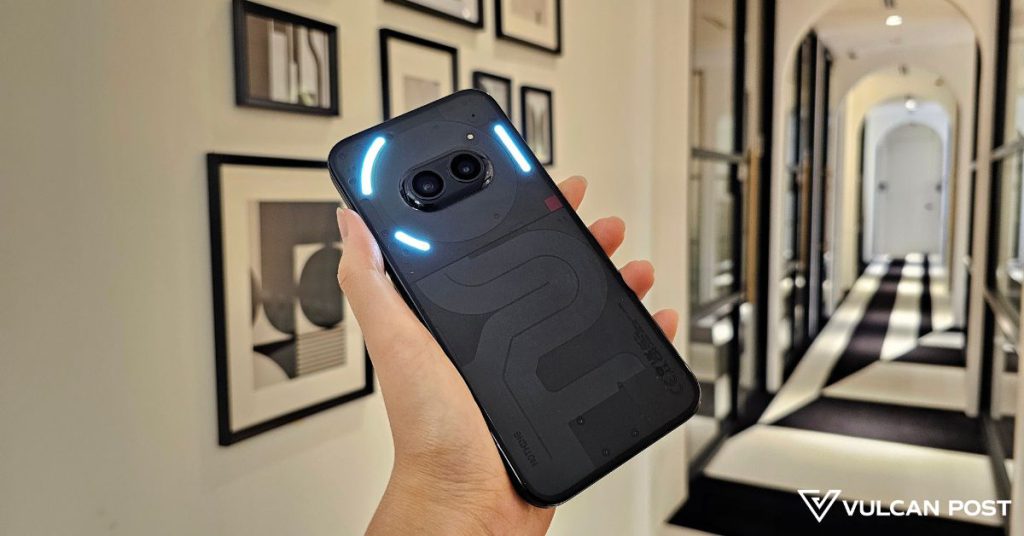
Knowing nothing about the Nothing Phone 2a prior to reviewing it, I had few expectations.
Sure, my colleague has reviewed (and raved about) the flagship Nothing Phone 2, and I’m a fan of the brand’s YouTube channel where Nothing CEO Carl Pei sometimes chats about criticism they’ve gotten or the tech.
But all I’ve really known the brand for are its funky LED lights (Glyphs, they call it) and transparent design.
So, what’s really in a Nothing phone, and a budget-friendly one to boot?
See Nothing, know Nothing
I’m not as swayed by the see-through design as my colleague is, although I do appreciate how visually different it is compared to the bunch of budget, mid-range, and flagship phones out there.
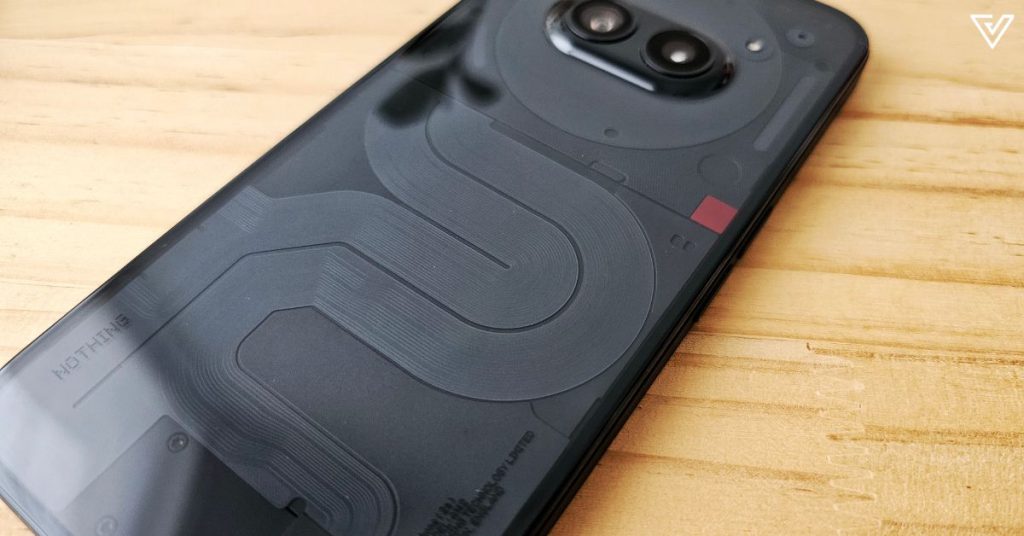
It certainly gives the brand its own identity—I’m confident I could clock a Nothing phone model in the wild, as opposed to wondering which generation of iPhone I’m looking at (bombastic side eye at iPhones 11 to 15).
And it’s not just the fact that I can see what’s under the hood of the phone (somewhat). Nothing has actually switched up its camera placement too.
The dual camera setup is now vertically smack-dab in the middle of the phone, and you’ll either love it or hate it.
One hater lovingly described it online, “Looks like a deformed cyclops that accidentally had two eyes grown side by side really close to each other, tf is this”.
Very imaginative, but anyway. The choice of just a dual-camera setup is a bold one in an age where a triple-camera setup is expected to be the norm.
Nothing previously explained this decision behind all their phones so far, saying that they didn’t want to follow the crowd and add more things just for the sake of having more.
Another point of note includes the curved plastic back (no wireless charging feature to be found here), so you’d want a case for that if you’re worried about durability.
On the front is a Corning Gorilla Glass 5, and the phone comes with a pre-applied screen protector too.
Nothing pleases in performance
As an Android user, the experience of using the Nothing phone feels pretty par for the course, but with more customisation than I’m used to on my Samsungs.
For example, you’re even able to adjust the size of your widgets, or change up the way your icons look (to a certain extent).
Whether you want your homescreen to look like the most organised thing in the world or scare/disgust anyone who so much as glances at your screen, the choice is yours.
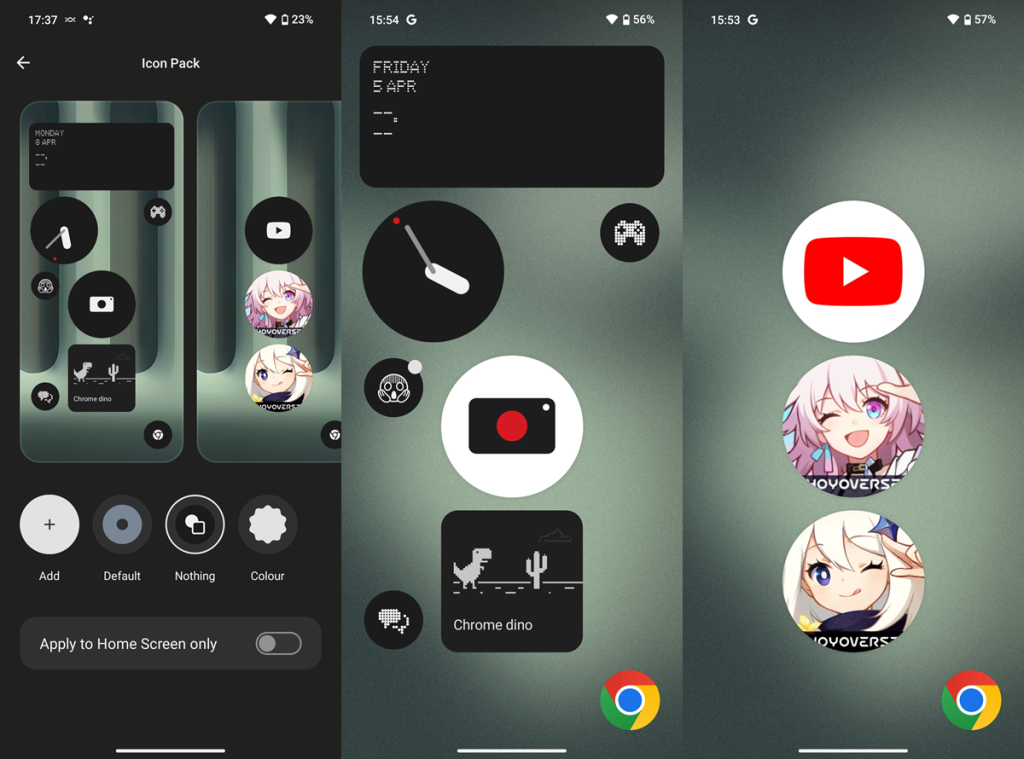
And now that my grotesquely huge Camera icon has caught your eye, here’s the low-down on the cameras.
You get a 50MP wide, 50MP ultrawide, and 32MP selfie camera, which are all pretty nice by my standards.


The HDR is solid, and the post-image processing gives each picture a pretty high contrast. In the image below, the picture to the left of the slider is non-HDR, and the right one is HDR.
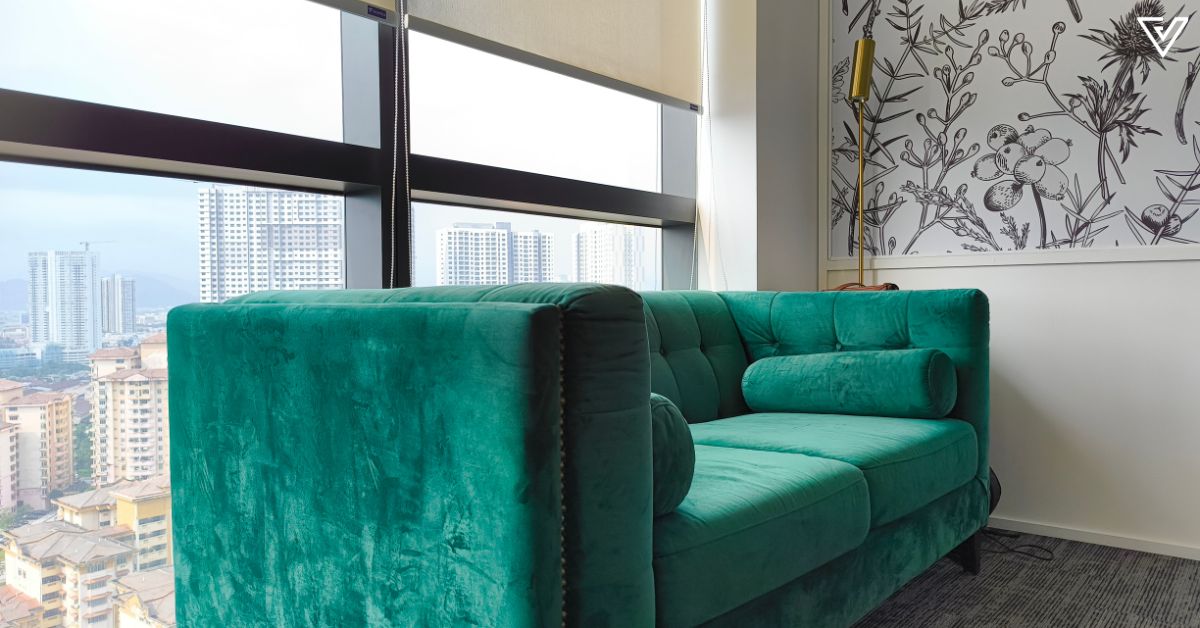

In my opinion, the photos are comparable to some flagship cameras.
Overall, no complaints here.
Equipped with a Mediatek Dimensity 7200 Pro chipset, I’m also impressed with how the phone handles casual gaming. I didn’t feel any significant heat-up even after an hour on the highest graphic settings.
Although there was some stuttering as I played Honkai: Star Rail, it didn’t ruin the gaming experience.
Battery life on the Nothing Phone 2a is another plus, as the 5,000mAh battery is enough to carry you well past a day if you’re not running battery-hungry apps on it.
Something to nitpick over
If I had to nitpick what I didn’t like about the phone, there would be two main things to point out.
First, the way YouTube’s UI looks in landscape mode while I’m watching a video on the Phone 2a. Look at the picture below and tell me that the way the settings icon is snuggled up against the border of the phone doesn’t bother you.
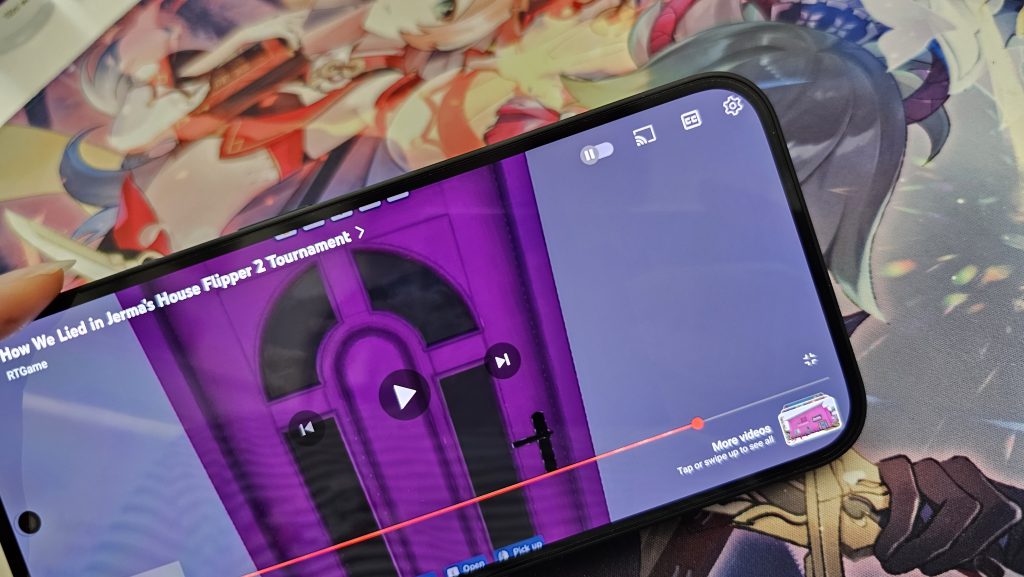
It’s truly odd, and it’s harder to press the icon too, especially if you have a thick phone case. As someone who spends quite a bit of my free time on YouTube, this is something that irks me, and I hope to see whatever this is addressed in the Nothing phone I review.
Another thing I don’t quite like about the Nothing Phone 2a is how there’s no native Gallery app for your photos. There’s only Google Photos, so by default, anything you snap or save goes straight to the cloud.
Some people may prefer this, but I do not. I don’t wish to have everything on the cloud, and I find it incredibly silly that once I use up my free 15GB of storage for my Google Photos, I might have to pay in order to keep more photos on my phone.
I did learn that you can access your images through Settings so perhaps the cloud storage thing isn’t as big of an issue as I think it is, but seriously, this method is equally as annoying.
Thankfully, it does seem like something may be in the works, but there’s still nothing official for now.
Verdict
The Nothing Phone 2a further builds upon the two things I think the brand stands for: simplicity, and identity.
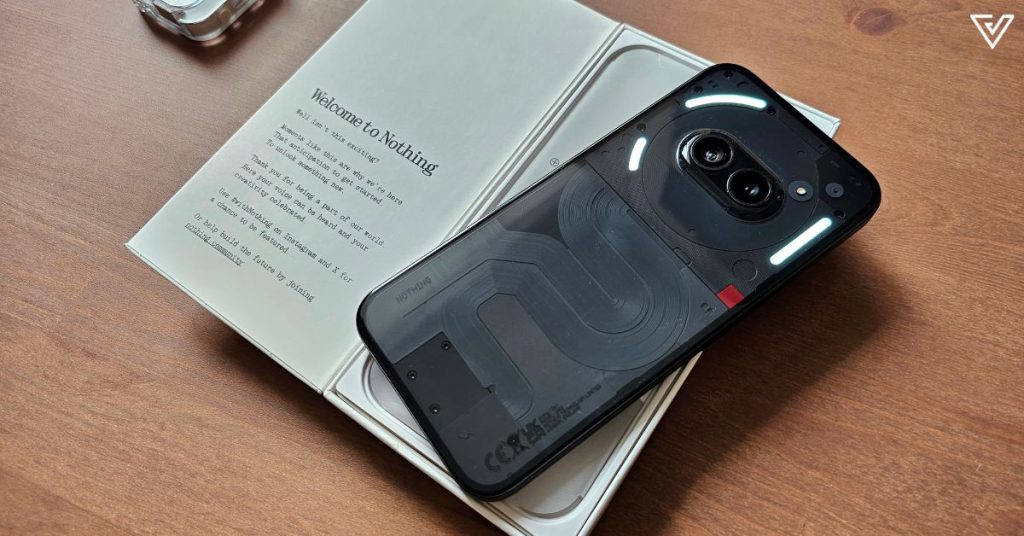
I say simplicity in the sense that the phone cuts out bloatware and frills to focus on doing the basics well. You could take the lack of a native Gallery app as an example for this.
Rather than providing a Gallery app and Google Photos, you get just the latter, so that you can snap pictures and save them on the cloud simultaneously, rather than switch from app to app. Some people will love this, while others may hate this.
Identity-wise, the phone carries a branding that’s unmistakably Nothing, from the transparent design to the glyphs and the customisability it gives users.
I think it’s clear that Nothing is still a budding brand, and while the user experience isn’t perfect yet, it’s well-rounded enough. This one’s for those willing to look past its current shortcomings to have a reliable and familiar (yet different) phone.
The Nothing Phone 2a comes in two colours for Malaysia: Black, and Milk, and is priced at RM1,699.
| Pros | Cons |
|---|---|
| Great cameras for the price point | Transparent back gets fingerprint smudges too easily |
| Long-lasting battery | YouTube UI in landscape mode is not optimised |
| Lots of customisability for users | No native Gallery app |
VP Verdict is a series where we personally try and test out products, services, fads, and apps. Want to suggest something else for us to try? Leave a comment here or send the suggestion to our Facebook page.
Also Read: Why M’sians need to join this 2-day event in PJ that’ll boost your understanding of IPs
How financial institutions & universities are reshaping their network through AI-native solutions

[This is a sponsored article with Juniper Networks.]
In a digital era where purchasing food from a hawker can be as easy as scanning a QR code with a phone, Payments Network Malaysia (PayNet) is often the driving force behind this seamless cashless experience in Malaysia.
For context, PayNet operates Malaysia’s payments network and serves as the central backbone for financial markets.
After the pandemic, the financial institution transitioned to hybrid work, reimagining its Kuala Lumpur headquarters and operations centre to be a more collaborative and flexible workplace.

Similarly, James Cook University (JCU) Singapore wanted to continue offering its students the flexibility to choose where they learn, whether online or through in-person classes.
What do these institutions have in common?
They wanted to up their networking game, both on and off-campus to give their stakeholders a better digital experience.
So, they turned to Juniper Networks (Juniper), a US-based company with a US$11.83 billion net worth offering software and network technology, for an AI-native networking solution.
But, what’s the problem with WiFi?
Back in the 2000s when WiFi became popular, most networks were designed for basic tasks like letting users connect to the internet. As more people started using personal devices like smartphones and laptops, the demands on these networks increased significantly.
It’s like how a small road designed for motorcycles suddenly had to handle lots of cars and trucks, causing traffic jams and delays.
“We live in a world where every connection counts, and it’s not just about connectivity, but the experience of a great connection,” Yedu Siddalingappa, Juniper’s AI-Native Enterprise Tech Lead Specialist elaborated.
“Imagine a large retail distribution centre, a school network, or a hospital facing a network outage even for a few minutes. It would result in millions of dollars of lost revenue, students unable to take tests, or healthcare workers unable to access life-saving information.”

As institutes try to improve their network systems, the IT servicing team has to deal with numerous different software and services that don’t always work well together.
And it takes a lot of time and effort to manually sort through everything and figure out what’s causing problems.
Studies show that more than half of the people who manage networks spend over 20 hours each week just fixing issues, and almost a quarter of that time is spent trying to find out what’s causing the main problems. It leaves them with little time and headspace to innovate and design a better solution.
That’s where AI-native infrastructure comes in.
How AI fixes the issue
With the AI-Native Networking Platform by Juniper, the network can smartly break traffic flows and redirect them to other “roads”, thus spreading the network’s load to accommodate more demands.
It’s called the Juniper Networks Enterprise Wired and Wireless LAN Infrastructure solution, where Juniper is named a 4x Leader in the Gartner® Magic Quadrant for Enterprise Wired and Wireless LAN Infrastructure.
Among its features includes Mist AI, which combines AI, machine learning, and data science to help online platforms seamlessly communicate with the network and each other, and to redirect traffic flow to reduce lags in the system.
“From real-time fault isolation to proactive anomaly detection and self-driving corrective actions, Juniper’s AI-Native Networking Platform furnishes campus, branch, data centre, and WAN operations with next-level predictability, reliability, and security,” added Yedu.
When it works as intended in the improved WiFi network at PayNet and JCU Singapore, its users should get fast, secure, and stable internet access everywhere at their respective headquarters and campus with little to no disruptions.
In addition, Juniper’s Mist AI comes with cloud-based management, which allows for centralised control, rapid deployment, and easy scalability.
This cloud-based system lets its users manage everything from the cloud with ease. This means that they can control and access all materials across online platforms that are constantly updated in the background with few bug issues.
When these systems work together at PayNet, the 500-person team can enjoy continuously optimised connectivity for laptops, printers, smart TVs, security cameras, and other IoT devices.
Guest WiFi has also been transformed from a tedious manual activity to a secure, automated process.

The technology can also make things more efficient.
For instance, Juniper’s Mist AI has a feature called Marvis, the Virtual Network Assistance (VNA) which acts like a smart helper for network engineers.
Instead of engineers having to figure out problems on their own, Marvis swiftly identifies and resolves issues remotely, eliminating the need for troubleshooting manually. This can save costs for institutions in the long run.
Moreover, Marvis’ efficient problem-solving capabilities can contribute to an organisation’s sustainability efforts. By resolving issues remotely, it results in an 85% reduction in travel for IT teams, aligning seamlessly with sustainable business practices and minimising environmental impact.
Ultimately, Juniper’s AI-Native Networking solution can help universities address issues with WiFi reliability and provide users with a secure and user-friendly network, making operations smoother.
As a result, Juniper’s solution allowed JCU Singapore to host a six-fold increase in connected devices, totalling to roughly 25,000 devices.
PayNet’s staff on the other hand, now have a better digital experience in the office. It has allowed them to stay focused on mobile payment innovation, and on maintaining the reliability, security, and scalability of Malaysia’s financial infrastructure.
Continuous innovations to foster growth
Of course, the requirements of financial and higher educational institutions will continue to evolve as time goes by, and Juniper networks provide adaptable solutions to enable growth.
For example, Juniper has recently added its new Marvis Minis to its AI-Native Networking Platform. It’s said to be the industry’s first and only AI-Native Networking Digital Experience Twin.
Put simply, Marvis Minis can mimic users on the network to understand how it’s set up, like a detective gathering clues without needing someone to show them around.
By doing this, it can spot problems early on, working alongside Mist AI to ensure everything runs smoothly, like a helpful team making sure the roads are clear before you start your trip, so you don’t get stuck in traffic.
The tool constantly learns as it ingests more data, using its growing knowledge base to proactively correct issues in real time.
Marvis Minis are capable of transforming how IT teams interact with enterprise networks across wireless access, wired access, and SD-WAN domains, thus making them an essential tool for IT teams.
Get tailored AI solutions
Every company has distinct network needs and would require a solution that can be tailored to seamlessly integrate with their existing infrastructure.
That said, implementing an AI-native network requires careful consideration and planning.
Companies can start by identifying the specific challenges they aim to address within their network infrastructure and by envisioning the capabilities they will require down the road.

“Most businesses understand the importance of networking, but not many are aware of the solutions available today to achieve their desired outcomes,” noted Yedu.
In this regard, Juniper aims to spread global awareness through events, webinars, training, and certification programmes.
Juniper’s upcoming AI-Native NOW, Live in Singapore event is a step in that direction.
“The event is primarily educational, and intends to share how AI can streamline networking operations and deliver the best user experiences, he shared.
IT industry professionals who want to learn more can do so by signing up your interest for Juniper’s AI-Native NOW, Live in Singapore, on May 9, 2024.
Registrations are subject to the organiser’s approval, which will be confirmed via the email you’ve registered with.
- Sign up for Juniper Networks’ AI-Native NOW, Live in Singapore event here.
- Read about other AI-related topics we’ve written here.
Also Read: What makes Dell’s lightest Latitude 13” essential laptop a worthy choice for digital nomads
Featured Image Credit: Payments Network Malaysia / Juniper Networks
4 scenarios where you’ll actually appreciate the security features in Samsung’s A35 & A55
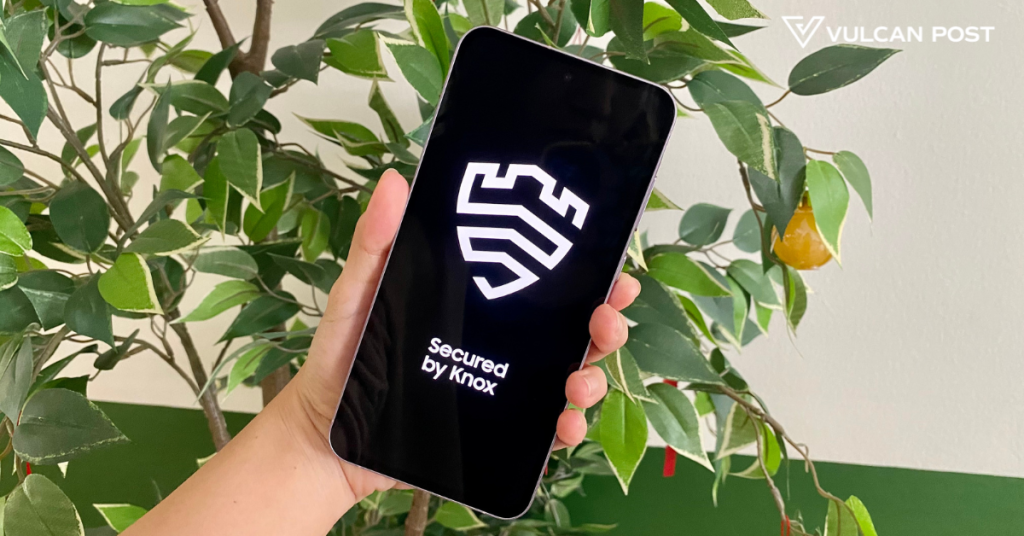
When new phones are released, people typically pay attention to only a few key upgrades, such as camera specs, battery life, processor speed, and phone design.
These are all important aspects to consider when thinking about whether you should purchase that latest device. But one key component that shouldn’t be overlooked is security.
After all, most of us heavily rely on our phones to connect with people, store sensitive information, and complete our work tasks.
Keeping this in mind, Samsung’s latest A series releases, the Galaxy A35 and Galaxy A55, are both integrated with advanced security features in the form of Samsung Knox to safeguard your data.
But just how useful is this for the everyday user?
You never know when you might need these security measures
Scenario one: Your phone gets stolen or lost
I know what you’re thinking, “I’m too cautious to just randomly lose my phone”. But the reality is that nobody anticipates misplacing their device, and it’s always a possibility when you’re out and about.
Hence, it’s recommended to set up a password to avoid people easily accessing your phone and extracting data. Some ways people can bypass this is by testing out possible password variations or hacking through a hardware attack.
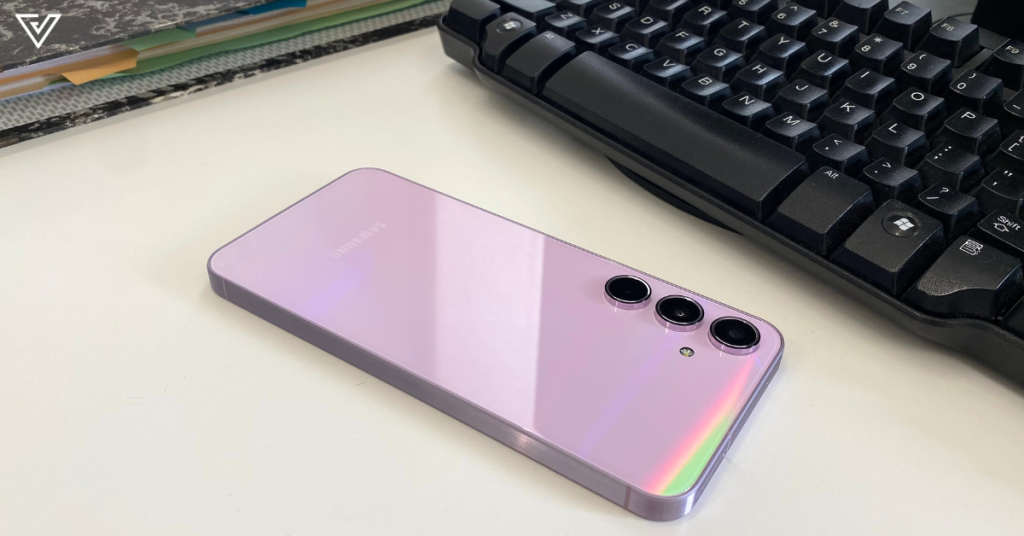
However, with the A35 and A55, passwords, PINs, and patterns are stored in Samsung’s Knox Vault which the brand explained is impossible to hack into. This is because it’s made to resist hardware and software attacks.
According to Samsung, Knox Vault doesn’t allow password hacking even with powerful forensic equipment. We’re by no means hackers and can’t test this for ourselves, so we’ll take their word for it.
At the same time, you can make use of Samsung’s Find My Mobile feature that allows you to lock and locate your device, and even completely wipe your data remotely.
Scenario two: You commonly receive phishing calls
Many of us would like to believe that we’re aware enough of scammers that we wouldn’t easily fall for their deceptive tactics. However, it’s better to be safe than sorry.
Moreover, just because you don’t fall for these scams doesn’t mean your loved ones wouldn’t. How often do we hear news reports of an auntie or uncle losing their life savings to these fraudsters?
Some steps to help identify that an urgent call is genuine and not fake include:
- Verifying their identity
- Being sceptical when they request sensitive information or demand immediate action
That said, I’m sure most of us would rather know from the get-go that the call is from a potential scammer. This would save us valuable time and effort from having to engage in pointless conversations, which is where Samsung’s Smart Call function comes in.
It acts as your personal scam detector and alerts you to potential fraud calls before you even pick up. You can also easily report and block the number to avoid future engagements with them.
Scenario three: You’re surrounded by people who like to snoop
In case nobody has told you yet, personal privacy is something that should be respected. This also extends to your personal devices like phones and laptops, so people shouldn’t be using them without permission.

In other likely scenarios, there are usually situations when you give people access to your phone but would still like to keep certain content private. This could be personal files, private conversations, or even sensitive media.
To overcome these awkward times, you could make use of Samsung’s Secure Folder. It’s a built-in app that creates containers to keep your data separately.
When establishing the Secure Folder, you’ll be asked to set up a password as well. This is how people won’t randomly gain access to it. And if your password for this is different from the main lockscreen, then it acts as a double lock.
Even if you have nothing to hide, adding your banking app to Secure Folder provides ease of mind when making online purchases. This is because Knox Vault encrypts and secures sensitive payment information like card details and transaction history.
Scenario four: You have a history of downloading malicious software
I don’t know about you, but my biggest fear with phones isn’t any of the above scenarios. It’s actually unknowingly installing malicious software that risks my data being remotely extracted.
Samsung acknowledges such threats and has created Auto-Blocker to act as a digital bouncer. Its main role is to block apps from unauthorised sources. When there’s suspicious activity while it’s installed, Auto Blocker will also detect and stop it.
According to Samsung, the Auto-Blocker is equipped to identify and block malicious advertisements containing malware. So if you’re a mobile gamer, this safeguards your gaming experience against harmful content.
The same goes to suspicious images, such as what might look like “proof of delivery” when you’re shopping online but actually contains APK malware.
Aside from that, it also takes into account the malware risk of charging in public places like the airport and connecting to non-personal PCs. This is particularly helpful if you’re a frequent traveller, desk nomad, or even a student.
What makes the Galaxy A35 and A55 special?
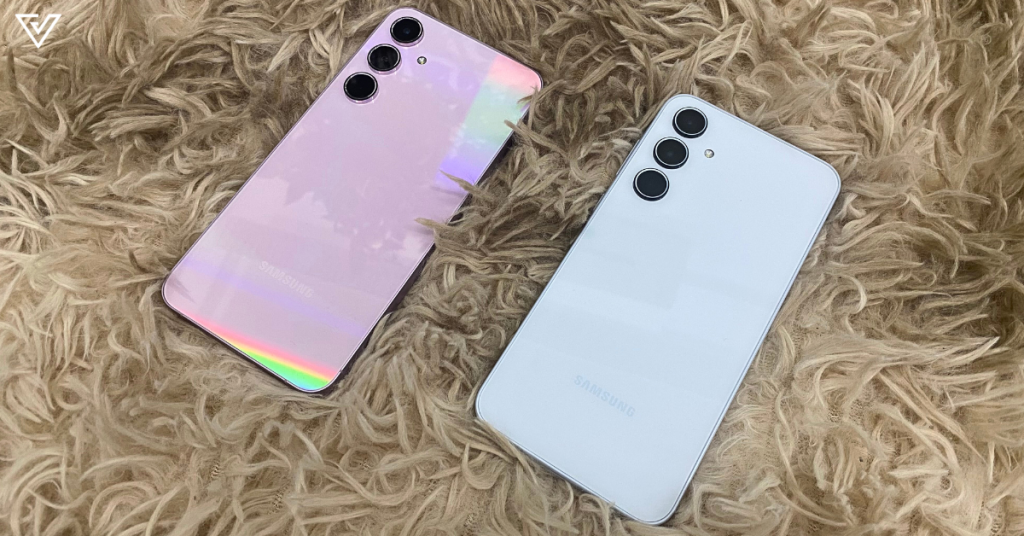
Unlike flagship models, phone models in Samsung’s A series don’t have their own processors in the application processors (AP). This means that it lacks the capability to enhance hardware supplementation.
In simpler terms, the hardware can be augmented which creates vulnerabilities that hackers could exploit.
But this wouldn’t be a concern with the Galaxy A35 and A55 because Samsung’s Knox Vault utilises secure integrated circuits (ICs) to store information. This makes them resistant to hardware attacks.
So if you’re looking to enhance the security of yours or your family’s mobile device at a decent price, then the Galaxy A35 (RM1,699) and A55 (RM1,999) might be good options for you. Personally, I’d consider them for the elderly in my family who aren’t as tech savvy and more vulnerable to digital threats.
Also Read: Employees need a Copilot to boost productivity & ease brain drain. This webinar shows how.
What makes Dell’s lightest Latitude 13” essential laptop a worthy choice for digital nomads

[This is a sponsored article with SNS Network.]
Imagine a world where your office view changes from sandy beaches to lush tropical forests, and your coffee breaks are spent in cosy corner cafes.
The ability to work from anywhere with the right laptop as your trusty companion is enticing for many adventurers in the digital age.
Even if your lifestyle isn’t as grand as that of an actual digital nomad, hybrid workers would know the struggle of lugging around your laptop and hastily setting up your workstation for the next appointment.
Thus, finding the ultimate laptop that can suit your needs may be tricky.
In that case, you might prefer having a device that’s designed with hybrid working features in mind, such as Dell’s 13″ essential laptop, the Latitude L3330.
In partnership with local IT solutions provider SNS Network, here’s a breakdown of the laptop’s features that make it a worthy choice for digital nomads.
1. You can easily bring it around if you’re on the go
The Latitude L3330 laptops are Dell’s lightest 13″ essential laptop.
Starting at 1.2kg, it is small, thin, and lightweight, making it easily portable for those regularly working on the go.
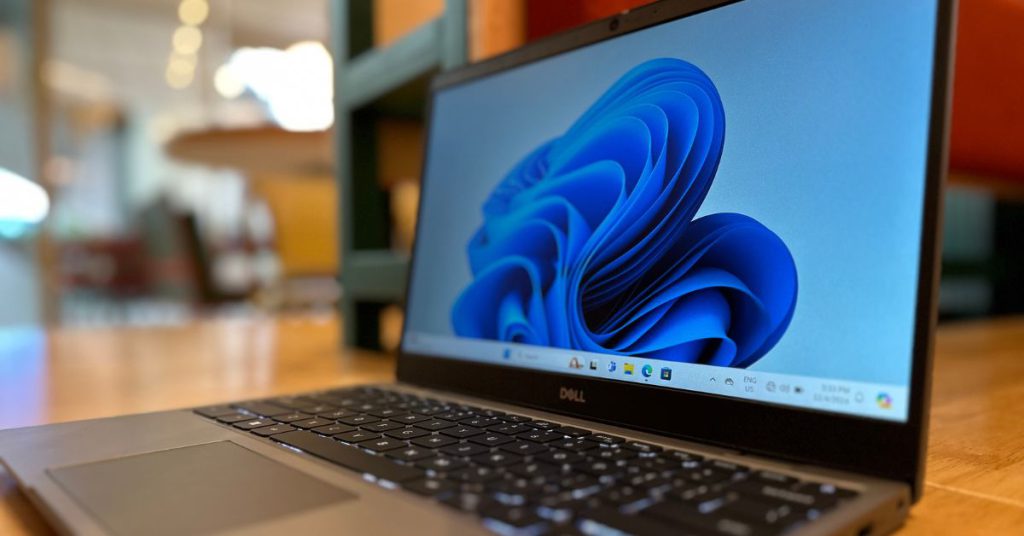
The laptop comes with a 13.3″ FHD (1920×1080) display, and a HD camera with a manual shutter that allows you to control when the camera shutter is open and closed, for better privacy.
For your productivity comfort, the Dell Latitude L3330 laptop boasts a large edge-to-edge keyboard and a mylar touchpad that feels smooth and glass-like.
2. You can maximise your connection anywhere
Have you ever been in a rush and needed to download a work document or media file but it’s going at a snail’s pace? Worse, there’s nothing much you can do about it but wait.
To curb that struggle, Dell’s Latitude 3330 laptop comes with what it calls intelligent connectivity.
It has a feature where you can simultaneously connect to two networks around you for faster data and video downloads.
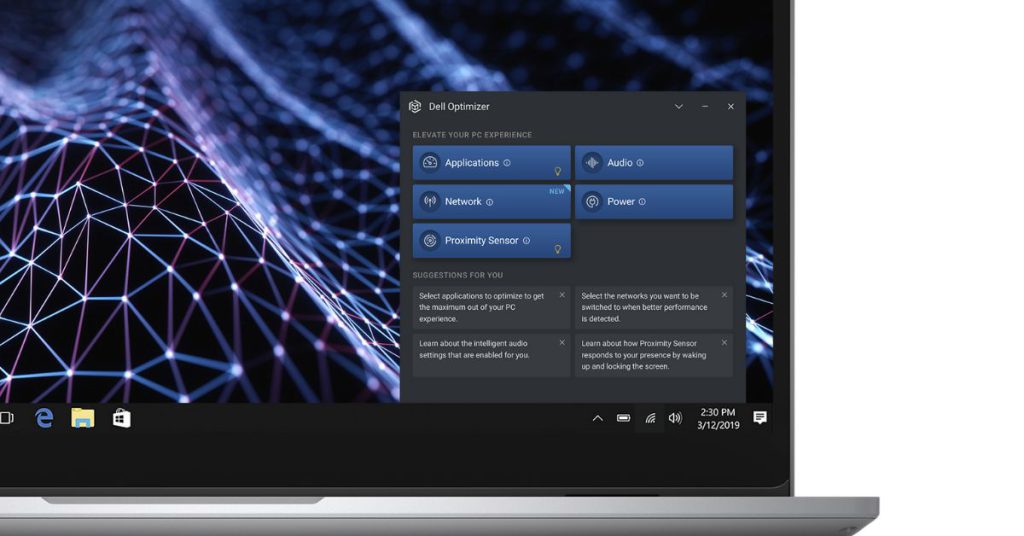
Speaking of connectivity, Dell’s Latitude 3330 laptops also come with all the ports you would need as a hybrid worker, including a USB 3.2 Gen 1 with PowerShare, USB Type-C, HDMI, and an audio jack.
This would negate the need for tiny dongles that easily go missing as you travel.
3. You can count on it to keep up with your work demands
Video calls are essential for digital nomads and hybrid working professionals.
Catering to this need, the Dell Latitude L3330 features Neural Noise Cancellation, which works both ways to cancel unwanted background noise from you and your caller.
According to Dell, the device’s performance is also optimised to its battery life, which can reach up to 80% charge in an hour with the brand’s ExpressCharge.
It’s a perk that will be appreciated by those working on the go, especially when you have limited time left to boost your laptop’s juice before the next meeting.

Powered by an 11th Gen Intel® Core™ i7-1195G7 and 12th Gen Intel® Core™ i7-1255U processors, the Latitude L3330 laptops also feature ExpressResponse. Based on your user behaviour, this feature can optimise your CPU to improve the performance of the apps you’re currently using.
4. You don’t have to break the bank
Offered in two variants, the Dell Latitude L3330 laptops are economically priced at RM2,499 and RM2,699 for the 11th Gen and 12th Gen processors respectively.
If you purchase with SNS Network—a Dell Technologies Titanium Partner and 100% trusted authorised reseller—on their Shopee or Lazada stores, you could further reduce the laptop’s price point with up to RM300 in vouchers available this April 25-27, 2024.
To make the deal more attractive, they’re also offering further savings of up to RM200* (T&Cs apply)
Under SNS Network’s limited-time promotion, you could also get the Dell E2222HS Monitor at a starting price of RM599.
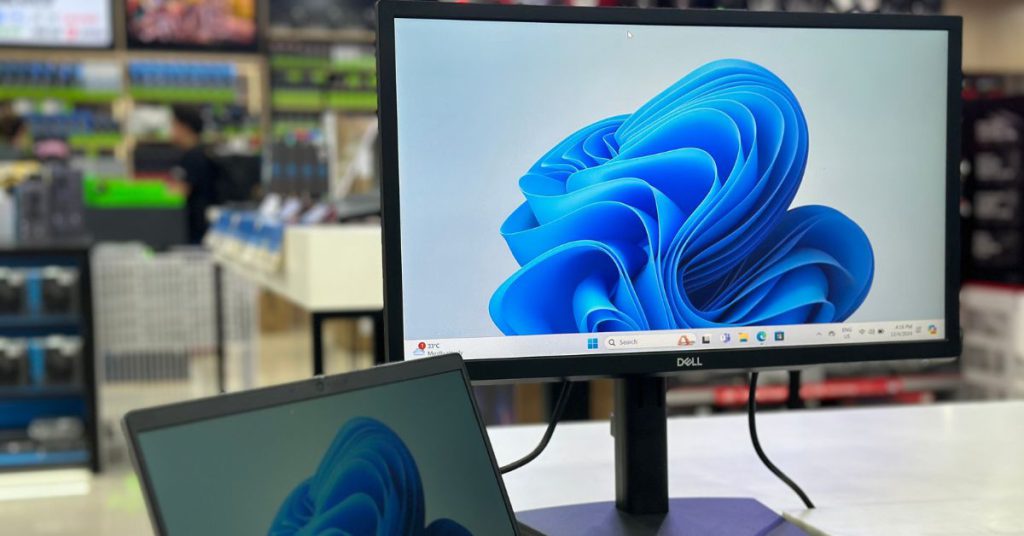
With a wide viewing angle on its 21.5” FHD screen and integrated speakers, the monitor would make a good addition to your home office if you’ve been eyeing an affordable dual-screen set-up.

- Get the Dell Latitude L3330 and E2222HS Monitor Lazada or Shopee.
- Learn more about SNS Network here.
- Read about other tech-related articles we’ve written here.
Also Read: Here’s the startup idea that won these Sixth Form students RM50K from 1337 Ventures
Featured Image Credit: SNS Network / Dell / Canva
M’sian biotech company debuts new fungus protein, we tried it in a 6-course meal
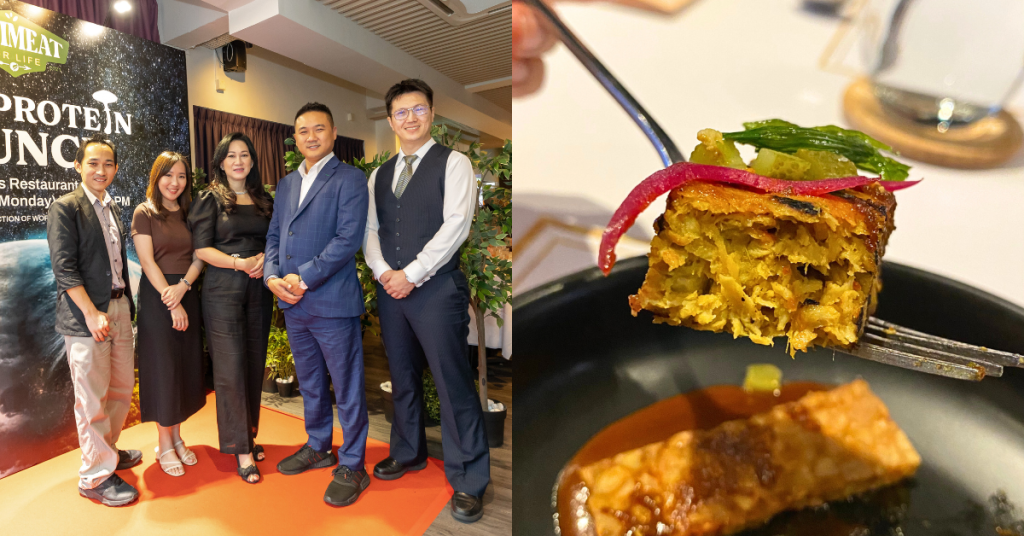
Heading to Damansara on a Monday evening isn’t our usual routine, but that’s where we were on April 16. Neither the slight traffic nor the additional hours to our workday managed to quash our excitement and cheery mood.
Why?
Because we were off to the launch of Ultimeat’s new product called Ultimeat Mycoprotein at The Nimbus Restaurant. And as part of the intimate event, we were given the opportunity to dine and taste just how this new offering can be used to prepare a variety of exquisite dishes.
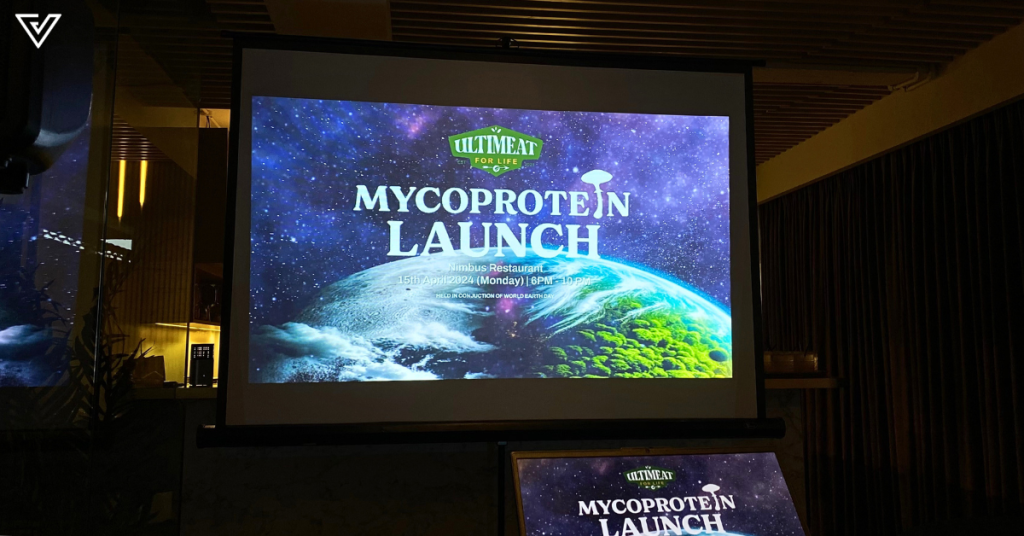
For context, mycoprotein is a type of protein derived from fungus, a category of living things that includes mushrooms.
This isn’t to be confused with regular mushrooms that you find in everyday dishes. Rather, mycoprotein production uses a technique called fermentation where harmless bacteria change its form over time.
Held in conjunction with World Earth Day happening on April 22, this new food item contributes to Ultimeat’s ongoing efforts to fight against climate change and promote sustainable food systems.
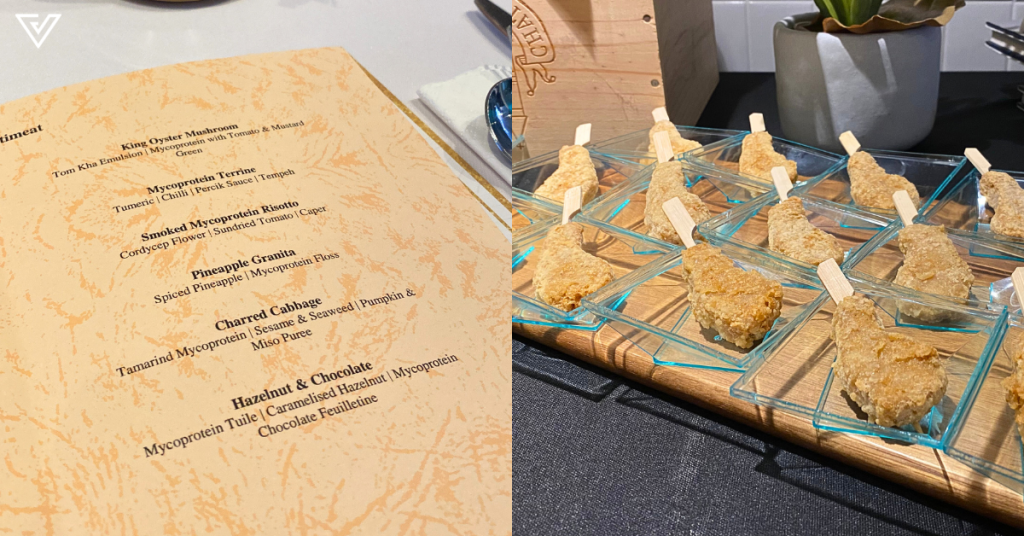
Speaking exclusively to Vulcan Post, the brand’s CTO, Yu-Wei Lin explained that this is a sustainable way of producing meat alternatives. “You can imagine [that] in the future, we don’t need to farm, we just need the [fermentation] tech. So [in] every city we can just build up a tank to produce mycoprotein.”
According to the brand, some benefits of mycoprotein are that it’s high in protein and fibre, and can be produced at faster rates with the use of biotechnology in a controlled environment.
Certified food scientist and co-founder of Ultimeat, Alfred Cheung, also wrote in The Sun that it contains low fat and sodium, and zero cholesterol.
So how does it actually taste?

The menu we were served was a hearty curation of fusion dishes in decent-sized portions. A six-course meal with four starters, one main, and a dessert, both my colleague Claudia and I left the event feeling properly full.
The first dish of the night was King Oyster Mushroom paired with a Tom Kha Emulsion. The mushrooms were stuffed with shredded mycoprotein and layered with tomato and mustard green chutney.
Inspired by Thai flavours, it tastes like regular stuffed mushrooms, but I couldn’t really put a name to the texture. You can tell it’s not traditional meat but it doesn’t taste like soy-based meat either. Claudia remarked that it reminded her of scallops.
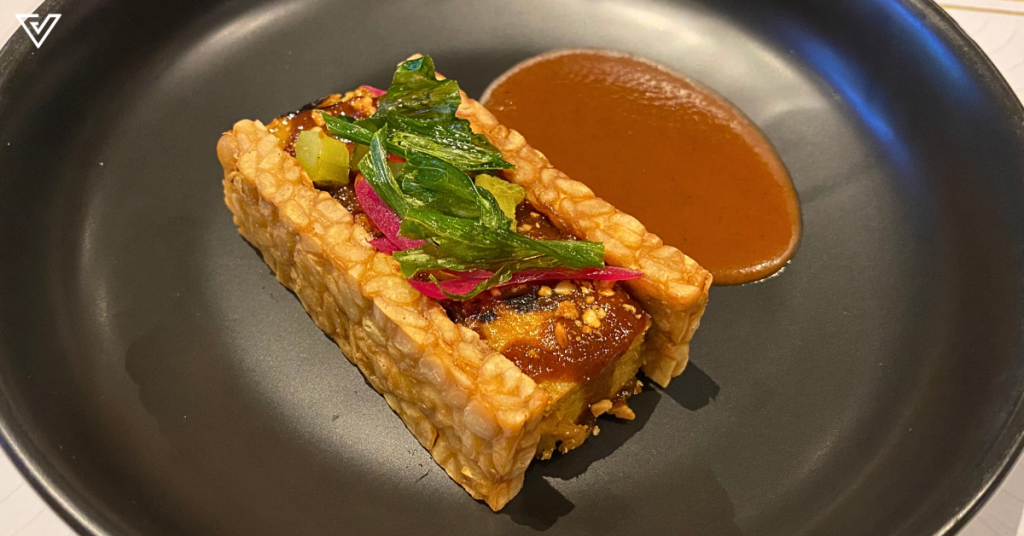
Next, we were served the Mycoprotein Terrine which is a rendition of satay and served with percik sauce and fried tempeh on the side. According to the chef behind these dishes and founder of Nimbus Restaurant, Chef Fred Choong, the terrine is made of 80% mycoprotein.
Taste-wise, it definitely lived up to its satay inspiration. I was pleasantly surprised to find that even in such large portions, the mycoprotein didn’t taste too rich (or for the lack of a better word, jelak).

This was followed by Smoked Mycoprotein Risotto, a course that in my opinion, really allowed for the mycoprotein’s original taste to shine. And by that, I mean that it’s pretty bland in a good way because it showcases how it doesn’t have to be the main star.
The concept is like porridge where you’ll find small chunks of mycoprotein in each scoop. To give the dish more texture and flavour, it’s topped with fried cordyceps that have been tossed with truffle oil and soy base and candied goji berries.
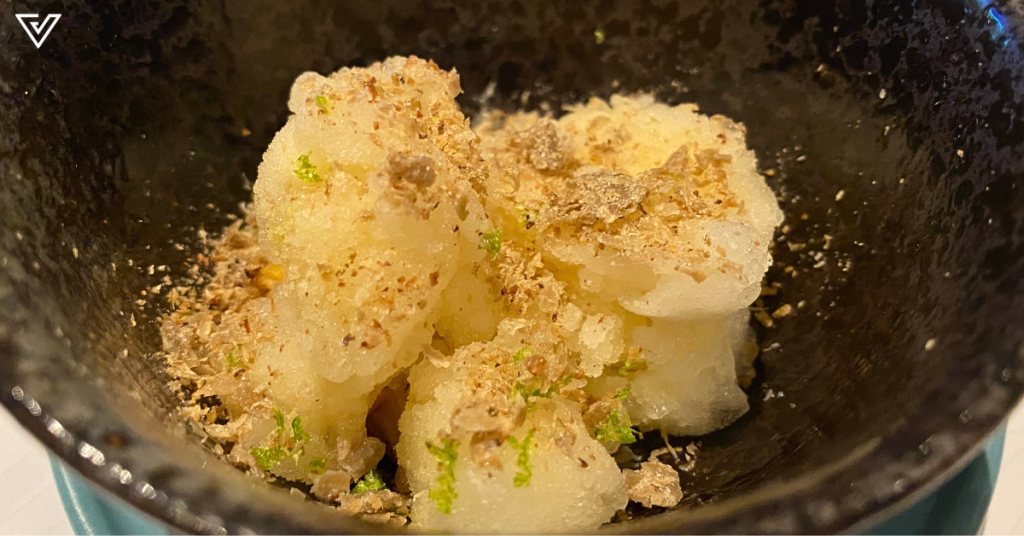
As a palate cleanser, Nimbus Restaurant whipped up a batch of Pineapple Granita. The mycoprotein came in the form of sprinkled floss meat and had a texture akin to serunding.
You wouldn’t think the elements would complement each other yet they oddly did. Though, Claudia didn’t find that the floss added much value to the overall taste, so to each their own.

The main dish of the night was Charred Cabbage that was layered with minced mycoprotein that’s flavoured with tamarind paste in between. To make the dish less dry, it was served with miso and pumpkin puree.
Chef Fred leaned more towards Japanese flavours with this course but both Claudia and I found it to be our least favourite one. The use of minced mycoprotein might not have been the best choice for this. I’d wager that the texture would make it a better fit for something more robust like chilli con carne or kebabs.

Saving the best for last, Nimbus Restaurant served us Hazelnut & Chocolate dessert. As its name suggests, the finale is hazelnut praline and chocolate mousse.
You wouldn’t be able to tell the dish had mycoprotein at first glance or first bite. But Chef Fred assured us that it was hidden in the golden leaf topping that is made of powdered mycoprotein. It’s also below the mousse in the form of dark chocolate-covered dehydrated mycoprotein.
Overall, the six-course meal exceeded our expectations and showed us just how versatile Ultimeat Mycoprotein could be.
A step forward in innovating the industry
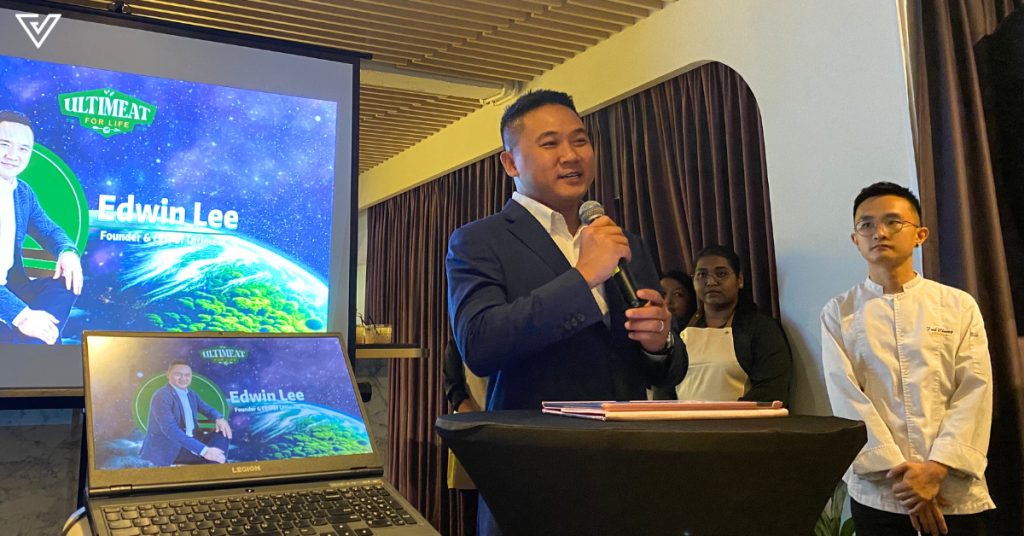
Established in 2021, Ultimeat has been in the local meat-alternative industry for a few years now. But the founder is actually a third-generation practising vegetarian. Hence, he’s committed to producing plant-based food that delivers in terms of texture, taste, and nutritional value.
Prior to this, the brand was only offering vegetarian products made of plant and soy-based ingredients, such as its Plant-Based Burgers Patties. Ultimeat calls this its Food 2.0 endeavour.
Now, its shift into the mycoprotein industry is under the brand’s Food 3.0 initiative. Ultimeat’s founder and CEO, Edwin Lee, shared that they’re planning to transition fully to mycoprotein in the coming years.
With a focus on B2B clients, the company will be working with restaurants first to guide them on developing dishes.
This is kickstarted by its collaboration with Nimbus Restaurant to curate a limited-time menu (RM388+ per pax) featuring Ultimeat Mycoprotein. It’s only available from April 15 to May 15, 2024, and marks the debut of the brand’s meat alternative in Malaysia.
Also Read: Employees need a Copilot to boost productivity & ease brain drain. This webinar shows how.
Featured Image Credit: [From left] Sam Kin Kit (Bioengineering Manager at Ultimeat), Estella Goh (Operations Manager at Ultimeat), Melissa Ong (Group Chief Officer at Impact Circle), Edwin Lee (Founder & CEO at Ultimeat), Dr. Yu-Wei Lin (CTO in Bioengeering at Ultimeat) / Vulcan Post
Changing people’s perception towards laundry, dobiQueen has grown to 82 stores in 8 yrs

Self-service laundrettes aren’t anything new in Malaysia. Chances are, there’s probably one not too far from you right now.
If you live in the Klang Valley, one brand you might be familiar with is dobiQueen. Founded by Nini Tan and Senglee Tan, the company now has 82 outlets across the region.
Before founding dobiQueen, both Senglee and Nini worked as digital marketing managers with Foto-ZZoom, a photography services company. In 2015, though, the two decided to start their own venture.
The inspiration to embark on the self-service laundry business came from personal experiences, Nini told Vulcan Post.
The co-founder explained that when she started living on her own, she struggled with juggling household chores alongside her demanding career.
“When I was young, I witnessed my mother experiencing the same struggles with household chores,” she shared. “There were days I remembered when I begged my mother to read bedtime stories to me but she could not relent as there were piles of laundry and other household cleaning to be sorted.”
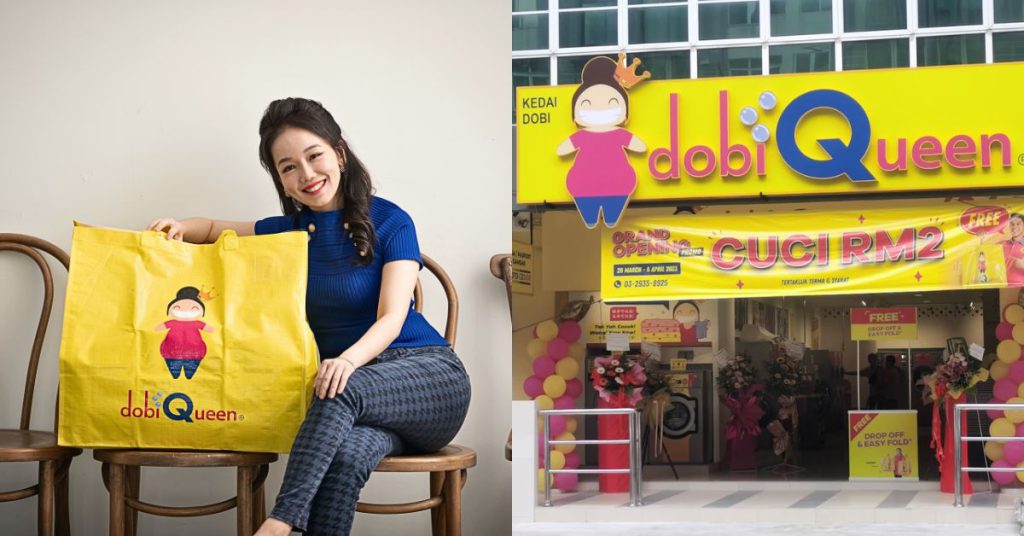
Realising that she shared the same struggles with her mother, Nini felt compelled to provide a solution. But as mentioned, self-service laundry shops are nothing new.
Yet, she felt like there was something missing.
“In my years of discovering the self-service laundry industry and building dobiQueen, I noticed a gap in the market where customers had to rush back to the laundromat to transfer their wet clothes to be put in the dryers due to the absence of staff,” she pointed out.
“That was when an idea came to mind on how the laundry industry could be greatly improved.”
Revamping the industry
Starting dobiQueen, Nini and Senglee wanted to revolutionise people’s perception towards laundry.
What differentiates dobiQueen from its competitors, Nini believes, is innovation and convenience. This is underpinned by the practice of having a supervisor at each store who can assist with customers’ laundry.
“With an assistant ready to assist with moving wet clothes to dryers as well as clothes stacking, our customers are free to go off to have a meal, exercise, or walk their pets as they have been granted one hour of free time,” she explained.
Adding to the convenience factor, Nini said dobiQueen rents parking spaces in crowded areas to ensure customers can easily drop off their laundry.
Essentially, dobiQueen hits a sweet spot between self-service and service.
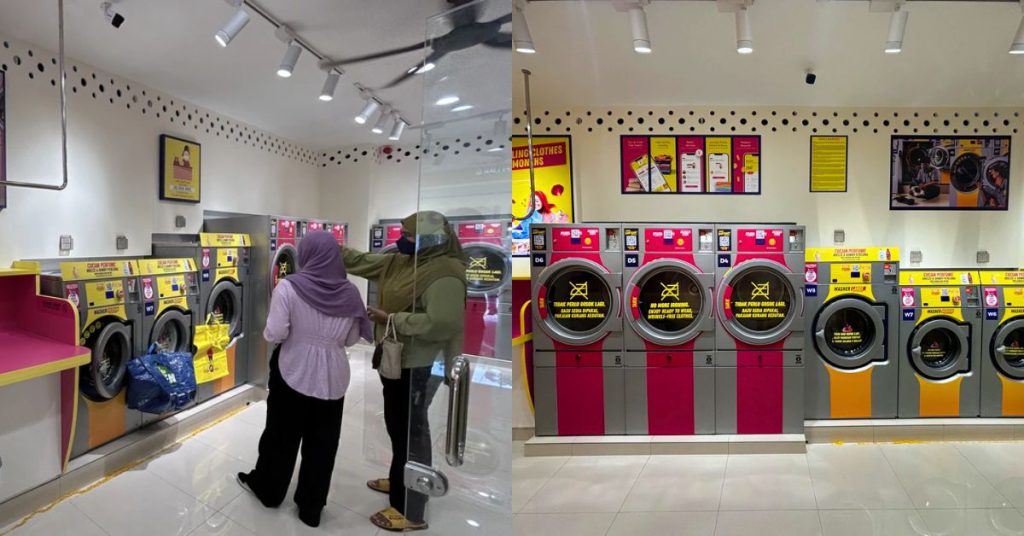
Nini also believes that dobiQueen stands out thanks to the quality it offers, as it utilises branded detergents and softeners such as Downy and Breeze. They also offer advanced machines, including crease-free dryers.
But perhaps the most unique service offered by dobiQueen is its door-to-door six-hour laundry pickup service, which is supposedly the first of its kind in Malaysia.
Through this service, dobiQueen allows customers to have their laundry picked up, cleaned, folded, and returned to them in as fast as six hours.
“I believe we have been pretty impactful by looking at our growth which has expanded from five outlets to 82 in just eight years,” Nini said. “That speaks volumes about our growth in the industry.”
This year, dobiQueen aims to open 20 more outlets. So far, all outlets are self-owned, but Nini mentioned the possibility of franchise opportunities down the road.
Giving back to the community
Beyond offering laundry services to the community, dobiQueen also empowers the workforce that it employs, focusing on hiring women, especially those from the B40 and single mothers’ communities.
“It all goes back to my own experiences growing up,” Nini said, recalling her mother’s struggles.

“But what struck me was that this is not just my story. It is the story of countless women out there. Women who are working tirelessly, often without recognition, to keep everything running smoothly at home and work.”
So, through dobiQueen, Nini wanted to do more than just run a business. Rather, she also wanted to make a positive impact on humanity, especially to mothers.
“That is where the name dobiQueen comes in,” she said. “It’s a nod to the queens of the household, the women who often bear the responsibility of keeping everything running smoothly on the home front.”
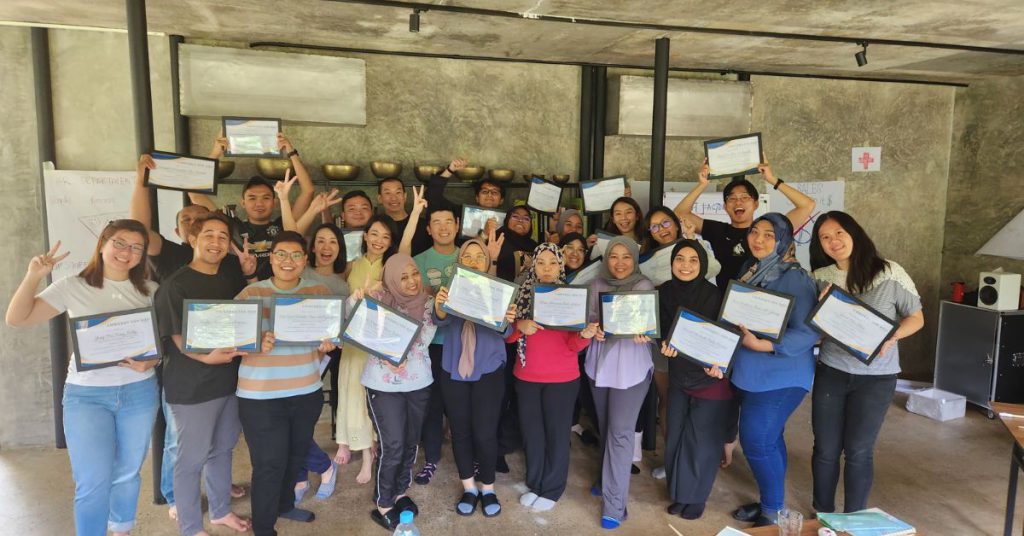
Aligning with this, dobiQueen is always cognisant about offering job opportunities to women, empowering them to take on leadership positions as well, both at the managerial level in outlets and within the corporate team.
“We have, to date, successfully employed eight single mothers,” Nini added. “Besides that, our company is dedicated to supporting women by purchasing festival gifts from NGOs.”
Some NGOs dobiQueen has worked with are Dignity for Children Foundation where they collaborated with refugee mothers, Kintry, which is run by a single mother entrepreneur, and The Asli Co., where they engaged with aboriginal mothers to handcraft soaps.
This year, the laundry company has also collaborated with Komuniti Tukang Jahit (KTJ) to create handmade pouches.
Growing and changing with the times
“Being an entrepreneur is not all smooth sailing,” Nini reflected on her journey. “Like any other business, we have faced our fair share of challenges along the way.”
What has helped, though, is practising a growth mindset. Much like developing muscles, Nini believes that with growth comes pain, but it trains them to overcome obstacles and adapt to changes fast.
She elaborated, “Challenges will always come our way, and with the growth mindset, seeing challenge as an environment that promotes growth, and increasing awareness, we have been able to keep moving forward.”
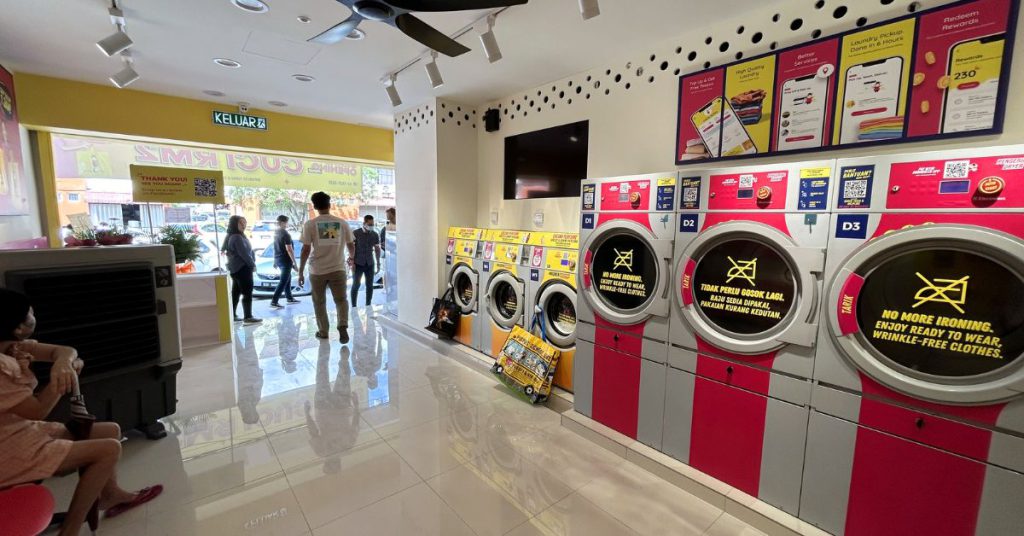
As such, the entrepreneur has learnt over the years that it’s important to invest in people and their growth. Today, dobiQueen invests in various trainings for its team, such as ones for effective communication.
Nini believes that investing in the team, which is the backbone of the company, will allow dobiQueen to achieve its ultimate goal—becoming the dominant, number one player in Malaysia’s laundrette industry.
Driving this goal is the same vision Nini has had since day one, which is to reduce the burden of household chores, allowing people to reclaim their time and energy.
“We measure our success not just by the number of outlets we have, but by the impact we make in people’s lives,” the co-founder shared.
“When we see families spending more quality time together because they do not have to worry about laundry, or when working adults have more time for themselves after a busy day, that’s when we’ll know we’ve ‘made it’.”
Also Read: Why M’sians need to join this 2-day event in PJ that’ll boost your understanding of IPs
Featured Image Credit: dobiQueen
Singapore career growth survey 2024: top 15 employers offering the best future prospects

For the past four years, LinkedIn, now owned by Microsoft, has used its vast trove of data to produce meaningful labour market research and publish its findings annually.
In this ranking, the company presents a list of 15 large companies offering the best career growth opportunities in Singapore, following a fairly strict methodology, based on eight pillars that it has identified as leading to career progression:
- Ability to advance – tracking employee promotions within a company.
- Skills growth – skills that employees gain during their time in the company.
- Company stability – a blend of attrition rates (companies which shed more than 10 per cent of the workforce in a given year are automatically disqualified) and employee retention of 3 years or more.
- External opportunity – tracking recruiter outreach to employees from the ranked companies.
- Company affinity – how closely workers bond with each other and how supportive the business is of its teams.
- Gender diversity – gender parity in the company and its subsidiaries.
- Educational background – looking at the variety of educational attainment among its employees, signalling openness to hiring people with diverse backgrounds.
- Employee presence in the country – the number of employees in the country relative to competing businesses.
In addition, the companies must have employed at least 500 people in Singapore as of Dec. 31, 2023.
All staffing companies, educational institutions and government are excluded from the ranking, as are both LinkedIn and its parent, Microsoft, to avoid accusations of bias.
Top Companies for 2024 according to LinkedIn
| Rank | Company | Industry | Details |
| 1 | DBS | Banking | Most notable skills: Commercial Banking, Criminal Law, Intellectual Property Most common job titles: Business Development Officer, Wealth Manager, Software Engineer Largest job functions: Finance, Engineering, Business Development |
| 2 | Schneider Electric | Automation Machinery Manufacturing | Most notable skills: Power Systems, Electronic Control Systems, Utilities, Instrumentation Most common job titles: Account Manager, Project Manager Largest job functions: Engineering, Sales, Operations |
| 3 | Standard Chartered | Banking | Most notable skills: Commercial Banking, Capital Markets, Software Development Life Cycle (SDLC) Most common job titles: Business Analyst, Business Development Officer, Product Team Manager Largest job functions: Finance, Business Development, Information Technology |
| 4 | American Express | Financial Services | Most notable skills: Travel Management, Commercial Banking, Sales Leads Most common job titles: Relationship Manager, Data Science Manager, Director Largest job functions: Sales, Business Development, Finance |
| 5 | OCBC Bank | Banking | Most notable skills: Commercial Banking, Insurance, Investment Banking Most common job titles: Business Development Officer, Financial Advisor, Financial Planner Largest job functions: Finance, Business Development, Sales * Remote job availability: 19.64% Hybrid |
| 6 | Singlife | Insurance | Most notable skills: Insurance, FinTech Most common job titles: Relationship Consultant, Application Developer, Claims Specialist Largest job functions: Business Development, Information Technology, Operations and Claims |
| 7 | Procter & Gamble | Manufacturing | Most notable skills: Inorganic Chemistry, Cosmetology, Retail Packaging Most common job titles: Brand Manager, Director of Business Development, Brand Director Largest job functions: Operations, Research, Marketing |
| 8 | BD | Medical Equipment Manufacturing | Most notable skills: Biomedical Engineering, Pharmaceutical Manufacturing, Product Testing Most common job titles: Manufacturing Engineer, Technical Support Specialist Largest job functions: Operations, Engineering, Information Technology |
| 9 | Abbott | Hospitals and Health Care | Most notable skills: Biomedical Engineering, Pharmaceutics, Product Testing Most common job titles: Assistant, Salesperson, Marketing Manager Largest job functions: Operations, Sales, Marketing |
| 10 | Mastercard | IT Services and IT Consulting | Most notable skills: Growth Strategies, Competitive Strategies, Management Accounting Most common job titles: Product Manager Largest job functions: Business Development, Product Management, Sales * Remote job availability: 98.36% Hybrid |
| 11 | Takeda | Pharmaceutical Manufacturing | Most notable skills: Oncology, Pharmaceutics, Medicine Most common job titles: Biotechnologist, Manufacturing Supervisor, Process Engineer Largest job functions: Research, Operations, Quality Assurance |
| 12 | Roche | Biotechnology Research | Most notable skills: Pathology, Physiology, Genetic Engineering Most common job titles: Quality Assurance Specialist Largest job functions: Research, Operations, Quality Assurance |
| 13 | S&P Global | Financial Services | Most notable skills: Journalism, Competitive Strategies, Capital Markets Most common job titles: Editor Largest job functions: Business Development, Media and Communication, Sales |
| 14 | Alphabet Inc. | Technology | Most notable skills: Competitive Strategies, Partner Development, Politics Most common job titles: Software Engineer, Program Manager, Account Manager Largest job functions: Business Development, Engineering, Marketing * Remote job availability: 70.37% Remote |
| 15 | HSBC | Banking | Most notable skills: Commercial Banking, Investment Banking, Capital Markets Most common job titles: Client Manager, Business Development Officer, Financial Planner Largest job functions: Finance, Sales, Business Development * Remote job availability: 31.48% Hybrid |
Financial hub
As you can see, despite Singapore attracting innovative tech companies, the ranking remains dominated by the old guard from the financial sector.
It doesn’t seem that it is likely to change anytime soon since every major business needs money to operate, so it’s only natural for a business hub to become a financial one as well.
The process is only accelerated by Hong Kong’s slow demise following the rather abrupt end to the liberties it enjoyed not so long ago. Intensifying competition between China and the West, prompting forecasts of inevitable decoupling and diversification, will draw billions of dollars away from the PRC and HK, with Singapore in a prime position to benefit from it.
But beyond finance, excellent employers are found in several branches of science and technology—healthcare, pharmaceuticals, machinery, biotech, or IT.
If you happen to be graduating in a STEM field you shouldn’t be starved of career opportunities — as well as future prospects in any of the listed companies.
Even though the job market is changing quickly, it is still possible to have a long, successful career in one place. According to LinkedIn’s data, these companies appear to stand out in 2024.